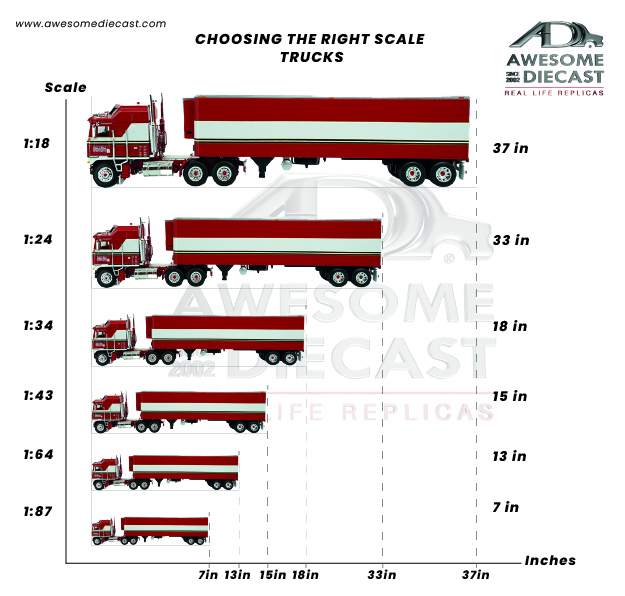How Custom Diecast Trucks Are Made: From Concept to Collectible
Custom diecast trucks fascinate collectors and hobbyists alike. Whether you favor diecast trucks, 1:24 scale model trucks, or even pint‑sized 1/87 Scale Trucks, understanding how a custom diecast creation goes from idea to finely detailed collectible is a journey worth taking. Let’s roll.
1. Concept & Scale Selection 🚛
Every custom diecast truck begins as a concept. Designers sketch ideas—vintage rigs, modern haulers, or fantasy vehicles. Once a theme is chosen, the next step is scale selection. Popular scales include 1.64 scale trucks, 1:24 diecast Trucks, 1:18 diecast Trucks, 1/43 scale trucks, and 1:87 Scale Trucks. Scale influences:
-
Detail level: Larger scales (like 1:18 or 1:24) allow for exquisite engine, interior, and chassis detail.
-
Collector preference: Some prefer the compact size of model diecast trucks or diecast model trucks for display simplicity.
-
Compatibility: Ensure your custom truck fits seamlessly with existing collections—check out more on scale guidelines at Amazing DieCast’s scale guide: Choosing the Right Scale Trucks.
2. 3D Modeling & Prototyping
After scale is set, designers create a 3D CAD model to define body shape, detailing, and articulation. Tools like SolidWorks or Rhino let creators preview cab, chassis, bed, tires, and details like mirrors and exhaust stacks.
Next comes prototyping—usually resin or 3D-printed “bodies” test fit before metal tooling. These prototypes let makers visualize real-world performance and refine details before investing in costly metal molds.
3. Mold Creation & Diecasting
This is the heart of producing diecast truck models. Once the prototype is approved, CNC-machined molds are built to exact specs. Molten zinc alloy is injected to form diecast bodies—creating the iconic solid feel of quality diecast model trucks.
Tooling costs can range from thousands to tens of thousands of dollars, depending on the intricacy and scale—whether you're crafting vintage diecast trucks or nimble 1:43 scale trucks.
4. Painting, Plating, & Detailing
With raw castings in hand, the finishing process begins:
-
Painting – High‑grade enamels and automotive sprays are applied. Custom colors and finishes—matte, metallic, or gloss—define your theme.
-
Chroming & Plating – Window frames, bumpers, grilles, and exhausts get shiny chrome coats or plating.
-
Decals & Tampo Printing – Precise logos, striping, license plates, and signage are tampo-printed or applied via decals to elevate realism.
-
Hand Detailing – Small touches like weathering, rust effects, or custom graffiti—especially on custom diecast trucks—bring unique character.

5. Assembly & Quality Control
Components—cab, chassis, wheels, interior pieces, clear windows—are snapped or screwed together. Hobbyists building diecast truck models at home might follow similar steps with aftermarket kits like 1.64 scale trucks or 1/87 Scale Trucks.
Every model is inspected for paint imperfections, decal alignment, wheel alignment, and overall integrity. Quality control ensures every final product meets the collector standard.
6. Packaging & Collectibility
Finished trucks are often packaged in display-ready boxes with blister windows. Some models—including 1:43 scale trucks or 1:24 scale model trucks—have collector numbering, certificates of authenticity, or commemorative plaques.
Limited-run custom diecast trucks can command high value on platforms like eBay, especially when:
-
They’re rare or limited‑edition
-
The theme is popular—like vintage diecast trucks
-
They boast intricate paint and detailing
7. Customization & Aftermarket Mods
Many enthusiasts modify factory models—adding photo-etched parts, wire harnesses, detailed interiors, or scratch-built components—to create one-off masterpieces. This aftermarket culture fuels communities dedicated to model diecast trucks and diecast truck models customization.
To equip yourself, check out aftermarket part suppliers on forums and marketplaces.
Why Scale & Detail Matter
Scale choice impacts detail and display possibilities. Want to build a fleet of 1/87 Scale Trucks for a railway diorama? Or showcase a few highly detailed rigs in 1:18 diecast Trucks scale? Each option carries trade-offs in size, cost, and realism.
For a clear comparison of scales—like 1:64 scale trucks, 1:24 diecast Trucks, 1:18 diecast Trucks, and 1/43 scale trucks—refer to my detailed guide: Choosing the Right Scale Trucks.
Final Thoughts
From initial sketch to prized collectible, the creation of custom diecast trucks is an artful process involving design, precision molding, exquisite finishing, and collector passion. Whether you're into diecast trucks, diecast model trucks, or niche scales like 1:43 scale trucks, understanding the journey allows for greater appreciation—in both collecting and building your own.
- Art
- Causes
- Crafts
- Dance
- Drinks
- Film
- Fitness
- Food
- Juegos
- Gardening
- Health
- Inicio
- Literature
- Music
- Networking
- Otro
- Party
- Religion
- Shopping
- Sports
- Theater
- Wellness


